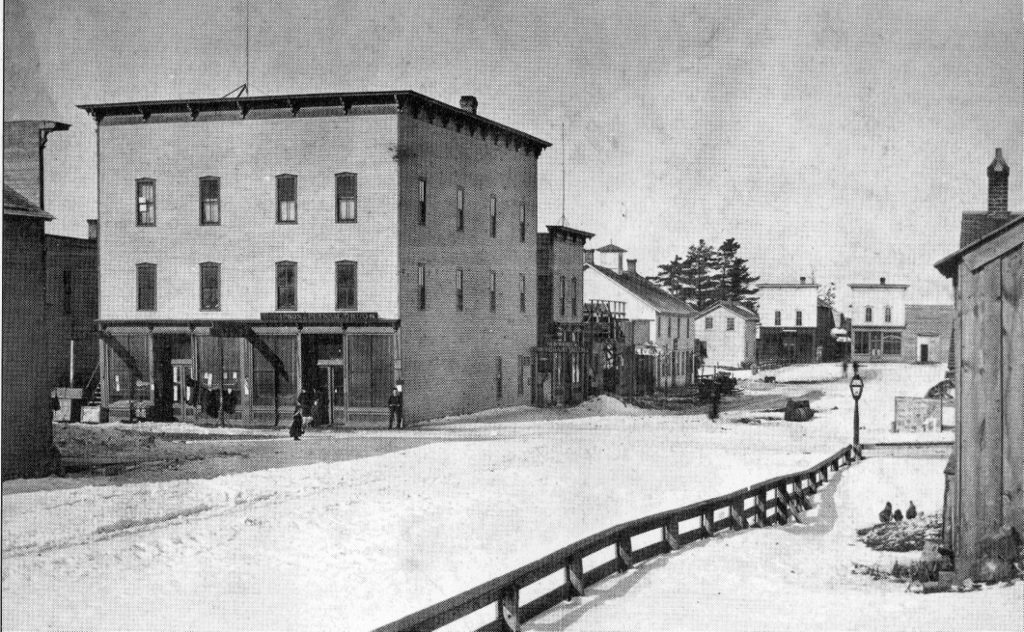On February 5, 1918, the sinking of the troop transport ship SS Tuscania sent shock waves across the nation, including the town of Manistique. The Tuscania was a former luxury passenger liner that had been pressed into service as a troop carrier by the United States Army. The Tuscania had sailed from Hoboken, New Jersey on January 24, 1918 with 2,013 soldiers and 383 crewmen on board. Despite being escorted by a British convey, the Tuscania was struck by a torpedo fired from a German submarine, and sent to the bottom of the Irish Sea. The vast majority of the troops aboard the Tuscania were rescued by the Royal Navy Destroyers Mosquito and Pigeon, but 210 souls were lost, including both military personnel and crewmen.
Tag Archives: Thompson
Manistique’s Great Fire of September, 1893

Pictured above is a circa 1890 photo of the corner of Cedar and Walnut Street in Manistique. The great fire of 1893 began in the rear of Paul Rediker’s Saloon on Walnut Street and quickly spread to adjacent buildings.
The great fire began at 11:15 in the evening on September 15, 1893. The undisputed cause of the fire was arson. Blue vaporous flames were seen leaping from the ground to the roof in the rear of the Alexander Richards building on Walnut Street. Splashing liberal amounts of either gasoline or coal oil against the side of the structure, the arsonist applied a match and disappeared into the shadows. The culprit was never brought to justice and his motive forever unknown.
Citizens spotted the flames almost immediately and turned in an alarm—but when the fire department arrived they confronted a raging inferno. All of the businesses and residences on Walnut Street were constructed with wood and were extremely dry. Gale force winds out of the northwest spread fiery embers to nearby buildings on Walnut Street and to businesses on Cedar Street. The Richards building, which was occupied by the Paul Rediker Saloon, was soon transformed into a pile of ashes. Occupants on the second floor of the building barely escaped alive. Other businesses on Walnut Street including saloons owned by Antowine Vassau and Fenton Gorman, along with the John Hackenbrach and Robert Knudson barbershops, the Bebeau Brothers livery and the John Kirstine tailor shop soon succumbed to the flames.
The Christmas Tree Ships
Chicago may not have an ocean, but we do have Lake Michigan. We are a maritime city. This is one day to remember that tradition, with the story of the Christmas Tree ships.
Around the turn of the 20th Century, the German custom of decorating Christmas trees was taking hold in Chicago. The closest evergreen forests were in northern Wisconsin and upper Michigan.
Each November a few lake schooners loaded up with trees and sailed them down to Chicago. Customers would come over to the Clark Street dock, go aboard a ship, and select their tree. It was fun way for city families to get into the holiday spirit.
Southtown & Jamestown – Timber Boom Towns That Once Was
The earliest reference to South Manistique or “South-town” is from the early 1880’s. The town was developed around the Hall and Buell Lumber Company Mill. The following description of Southtown is from Earnest Williams: “Several houses in the town had four feet high fences around them to prevent the sand beach from blowing into the yards. All the streets were sand and grass was basically nonexistent.”
Hall and Buell lad lumber rights around Southtown and on Indian Lake. They cut the timber and floated it across Indian Lake to a “pull up” between Sunset and Harrison Beaches. From there it was loaded onto their own railroad and brought to the Southtown mill (The railroad crossed old U.S. 2 near the current location of WTIQ and the gas pipeline).
